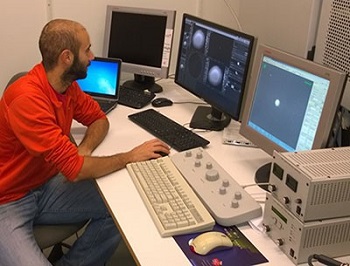DELMIC develops and manufactures products which are focused on high performance, user friendly, integrated microscopy solutions. Users of the SPARC technology at Chalmers University of Technology in Gothenburg, Sweden are applying cathodoluminescence measurements to study the properties of nanophotonic devices.
 Dr Ruggero Verre processes data from his DELMIC SPARC system to aid the characterisation of optical antennas.
Dr Ruggero Verre processes data from his DELMIC SPARC system to aid the characterisation of optical antennas.
Dr Ruggero Verre is a post-doctoral researcher in the Department of Applied Physics - Division of Bionanophotonics at the Chalmers University of Technology in Gothenburg in southern Sweden. His work in the group headed by Professor Mikael Käll focuses on optical antennas, devices that are capable of focusing, amplifying and manipulating light on the nanoscale. Gold and silver particles are used for this application and, in this form, are known as plasmonic antennas. The applications of plasmonic antennas are numerous: they have been proposed as the key elements for the next generation of solar cells, as biological sensors and as an amplifier of optical signals to answer fundamental questions on the interaction between light and matter at the nanoscale level. Professor Käll's research group focuses on all these aspects of plasmonic antennas.
To benefit from the incredible properties of plasmonic antennas in real life, the first step is to answer a simple question: how does a plasmonic antenna work? To this end, cathodoluminescence is a fascinating and powerful tool because it allows researchers to "see the direction of light." The colours of a nanoscale object are observed with unprecedented resolution. In this way, it is possible to unravel and understand their fundamental properties. Given this, it is possible to think how these structures may be used. For example, plasmonic structures concentrate light in very specific locations depending on their shape, dimensions and materials. By understanding this, it becomes possible to place molecules or quantum objects in certain positions to amplify their interaction with light.
Dr Verre prepares his nanostructures in a cleanroom environment using lithographic tools. Prior to coming across cathodoluminescence, characterising them was his biggest challenge. Now, Dr Verre is able to characterise his latest, exotic structures quickly and efficiently.
This capability is now available as a retrofit for Scanning Electron Microscopes (SEM). The SPARC system from DELMIC is unique due to its modularity, sensitivity and reproducibility. The electron beam of the SEM is used to excite nanostructures and the cathodoluminescence detector is subsequently used to detect the produced light. The higher detection efficiency not only leads to better results, but also makes it possible to do a whole new type of nanophotonics research; angle resolved measurements. With this new detection method, the direction in which the light is emitted from an excited structure can be mapped. The light generated by the electron beam is picked up by the parabolic mirror and coupled outside the vacuum chamber of the SEM. The user may then choose between obtaining a 2D image of the mirror - which may be used for angle resolved measurements - or a spectroscopic image.
Dr Verre made some observations on why he likes the design of the system. “I see two technical advantages. The first is the mirror design which may be moved in all directions including rotation. These degrees of freedom allow us to achieve precise and reproducible control for repeatable results. The angle-resolved possibilities with ad-hoc analysis have the potential to be most useful. The SPARC system was designed with the idea to image the angular light emissions of different structures using a CCD camera. However, analysis and development of the ability to generate results was not straightforward. DELMIC has developed an integrated solution and provided excellent one-to-one support which has been of help to our research.”
For more details about DELMIC's SPARC system and its applications in nanophotonics, please contact DELMIC on +31 (0)15 7440158 or visit the web site: https://www.delmic.com/en/